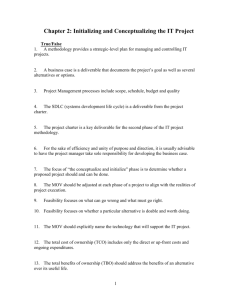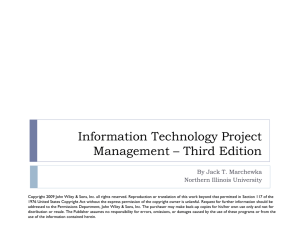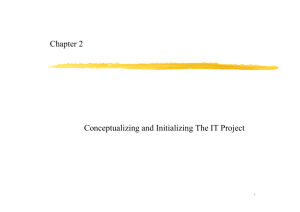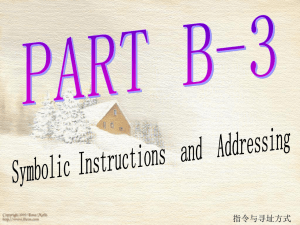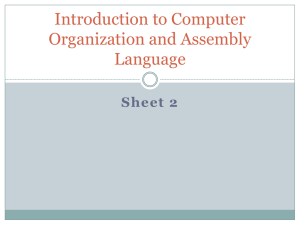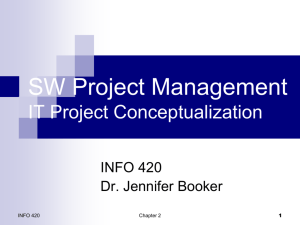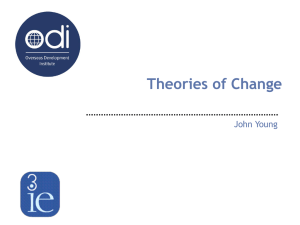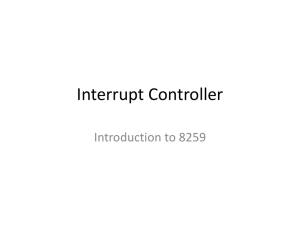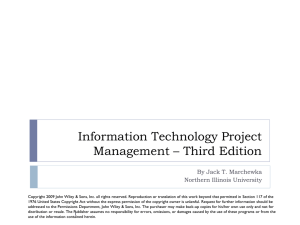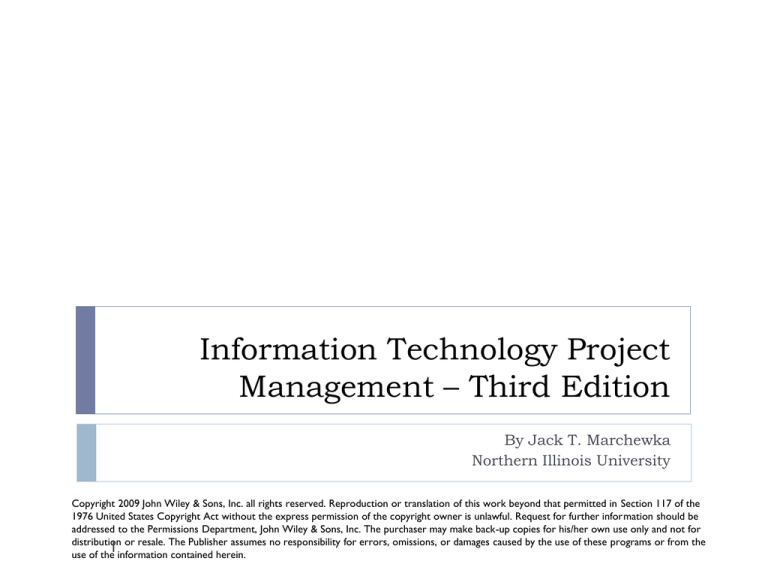
Information Technology Project
Management – Third Edition
By Jack T. Marchewka
Northern Illinois University
Copyright 2009 John Wiley & Sons, Inc. all rights reserved. Reproduction or translation of this work beyond that permitted in Section 117 of the
1976 United States Copyright Act without the express permission of the copyright owner is unlawful. Request for further information should be
addressed to the Permissions Department, John Wiley & Sons, Inc. The purchaser may make back-up copies for his/her own use only and not for
distribution or resale. The Publisher assumes no responsibility for errors, omissions, or damages caused by the use of these programs or from the
1
use of the information contained herein.
Conceptualizing and Initializing
the Project
Chapter 2
2
Information Technology Project Methodology
Methodology
A strategic-level plan for managing and controlling the project
Game plan for implementing project and product lifecycles
Recommends phases, deliverables, processes, tools, and
knowledge areas for supporting an IT project
Must be flexible and include “best practices” and “lessons
learned” from successful and unsuccessful experiences over
time.
Should lead to fewer wasted resources and projects that
provide true value to the organization
Can be
Traditional (e.g., Waterfall)
Agile (e.g., XPM, SCRUM)
3
An IT Project Methodology
Figure 2.1
4
Phases
Phase 1: Conceptualize and Initialize
Define the overall goal of the project – most important step in
the ITPM
Project is undertaken for a specific purpose and that purpose must be
to add tangible value to the organization
Aids in defining the project’s scope, guides decisions throughout the
project life cycle and will be used to evaluate the project’s success
Identify alternatives along with the costs, benefits, feasibility and risks
The project’s goal and analysis of alternatives that support the
goal are summarized in a deliverable called the business case
Senior management uses the business case during the selection
process to determine whether the project should be funded
5
Phases
Phase 2: Develop the Project Charter and Detailed
Project Plan
The project charter is a key deliverable of this phase
The project plan provides all the tactical details concerning
Defines how the project will be organized and implemented
Identifies and gives authority to a PM to begin carrying out the
processes and tasks associated with the SDLC
Who is the PM, plan sponsor, project team
What is the scope, resources, tools, technologies, value to the org
How long, how much
The project’s scope, schedule, budget, and quality objectives
are defined in detail
6
Phases continued
Phase 3: Execute and Control the Project
Carry out the project plan to deliver the IT product
The project team uses a set of systems analysis and design
tools for implementing the SDLC
Must have people with appropriate skills on board, risk plan,
quality management plan, change management plan, testing plan,
communication plan, etc.
Phase 4: Close Project
Formal acceptance should transfer control from the
project team to the client or project sponsor
Project team should prepare a final report to document
and verify that all deliverables have beenmet
Phases continued
Phase 5: Evaluate Project Success
Post mortem by project manager and team of entire
project
Evaluation of team members by project manager
Document lessons learned and best practices to improve
organization’s methodology for future projects
Identify strengths and opportunities for improvement to help
maximize each person’s potential
Outside evaluation of project, project leader, and team
members
Evaluate project’s organizational value
Project Management Process Groups
A process is a series of actions directed toward a particular result
Project management can be viewed as a number of interlinked
processes
The project management process groups include:
Initiating processes
Planning processes
Coordinating people and resources to carry out the various plans and produce
the products, services or results of the project or phase
Monitoring and controlling processes
Devising and maintaining a workable scheme to ensure that the project
addresses the organization’s needs
Executing processes
Defining and authorizing a project or project phase
Regularly measuring and monitoring progress to ensure that the project
objectives are met
Closing processes
Formalizing acceptance of the project or phase, closing out contracts,
documenting lessons learned
9
Level of Activity and Overlap of Process
Groups Over Time
10
Mapping the Process Groups to the
Knowledge Areas
You can map the main activities of each PM process
group into the nine knowledge areas using the
PMBOK® Guide
Note that there are activities from each knowledge
area under the planning and monitoring and
controlling process groups
Information Technology Project
11
Process Groups and Knowledge Area Mapping
12
Process Groups and Knowledge Area Mapping
13
Process Groups and Knowledge Area Mapping
14
IT Project Management Foundation
Project Management
Process Groups
15
Initiating processes
Planning processes
Executing processes
Controlling processes
Closing processes
Project Objectives
IT Project Management Foundation
Tools - e.g. Microsoft Project ®, Computer Aided
Software Engineering (CASE)
Infrastructure
Organizational Infrastructure
Project Infrastructure – supports the project team in terms of:
Project Environment
Roles and Responsibilities of team members
Processes and Controls
Technical Infrastructure
How projects are supported and managed
How resources are allocated, reporting relationships of the PM and
team members, role of project
hardware and software tools to support the project team
Project Management Knowledge Areas
16
The Business Case
Definition of Business Case: an analysis of the organizational value,
feasibility, costs, benefits, and risks of the project plan.
Attributes of a Good Business Case
Details all possible impacts, costs, and benefits
Clearly compares alternatives
Documents methods and rationale used to quantify costs and benefits
Objectively includes all pertinent information
Shows explicitly how an investment in IT will lead to an increase in
business value
Systematic in terms of summarizing findings
Provides senior management with all the information needed to
make an informed decision as to whether a specific project should
be funded
17
Process for Developing the Business Case
Figure 2.3
18
Developing the Business Case
Step 1: Select the Core Team
Advantages:
Credibility - all stakeholders and relevant
departments involved
Alignment with organizational goals
Access to the real costs
Ownership
Agreement
Bridge building - include critics on the team
19
Developing the Business Case
Step 2: Define Measurable Organizational Value (MOV)
The project’s goal - measure of success
Must be measurable
Provides value to the organization
Must be agreed upon
Must be verifiable at the end of the project
Guides the project throughout its life cycle
Should align with the organization’s strategy and goals
20
The IT Value Chain
Organizational
Vision & Mission
Supports
Drives
Organizational
Strategy
Supports
Figure 2.4
Drives
Project’s
Organizational
Measurable
Value
(MOV)
21
The IT Value Chain
prevent customers
from
leaving or
Organizational
Vision
& Mission
switching
to a
competitor
Supports
Drives
develop tighter
Organizational
linkages
with
Strategy
customers
Supports
Drives
Project’s
Develop
a B2B
Organizational
application
to allow
Measurable
customers
Valueto do
business
on-line
(MOV)
22
IT Value Chain
President Kennedy’s mission to the moon –
clear and measurable goals without saying
how to accomplish the goal
“Our goal is to land a man on the moon and
return him safely by the end of the decade”
A human being and not a monkey or unmanned
rocket
Get him back safely to earth
Do this by 1970
http://www.youtube.com/watch?v=E8zejVPn30&feature=fvwp&NR=1
23
Process for Developing the MOV
Example: A company wants to develop and implement a B2C ecommerce application to expands its current brick and mortar
operations
a)
Identify the desired potential area of impact – why does the
organization want to take on the project
Strategic
Customer
Financial
Operational
Social
B2C – PM meet with plan sponsor to determine how the idea for the
project came about to understand how and why decisions are made by
sponsor’s organization. Strategic & financial – expand b&m operations
24
25
Process for Developing the MOV
b)
Identify the desired organizational value of the IT
project – how will this project help achieve what
we want as an organization
Better?
Faster?
Cheaper?
Do More? (growth)
B2C – enable the organization to expand its current operations
Improved customer service and operations would fall under
better, faster and cheaper
26
Process for Developing the MOV
Develop an Appropriate Metric - should it
c)
increase or decrease?
Company needs a way to determine if project is a success
and if their investment paid off
Money ($, £, ¥ )
Percentage (%)
Numeric Values (customers, hits on website)
B2C – plan sponsor has set the metric to be a 20% return on
investment and 500 new customers
27
Process for Developing the MOV
Set a time frame for achieving the MOV
d)
When will the MOV be achieved?
Completion of the project does not mean the MOV has been
achieved.
MOV can change as time passes
B2C – plan sponsor has set the metric to be a 20% return on
investment and 500 new customers within first year. 25% return
and 1000 new customers second year, 30% return and 1,500 new
customers third year.
28
Process for Developing the MOV
Verify and get agreement from the project
stakeholders
e)
Ensure that it is accurate and realistic
Project manager and team can only guide the process, plan
sponsor identifies the vale and target metrics
PM should not commit to an unrealistic MOV
29
Process for Developing the MOV
Summarize the MOV in a clear, concise statement or
table
f)
Opportunity to get final agreement and verification
Simple and clear directive to the project team
Sets explicit expectation for all project stakeholders
This project will be successful if _________________.
MOV: The B2C project will
provide a 20% return on
investment and 500 new
customers within the first
year of its operation
Year
MOV
1
20% return on investment
500 new customers
2
25% return on investment
1,000 new customers
3
30% return on investment
1,500 new customers
30
Developing the Business Case
Step 3: Identify Alternatives
Base Case Alternative – how would the organization would
perform under the status quo
Determine costs of maintaining the current system over time
Increased maintenance costs of hardware and software
Possibility of more frequent system failures and downtime
Possible Alternative Strategies
Change existing business processes without investing in IT
Adopt/Adapt systems from other organizational areas
Reengineer existing system
Purchase off-the-shelf applications package
Custom build new solution using internal resources or outsourcing
31
Developing the Business Case
Step 4: Define Feasibility and Asses Risk
Feasible – doable and worth doing
Economic feasibility – too costly and/or not provide expected benefits
Technical feasibility – can infrastructure, IT staff, vendor support the
solution
Organizational feasibility – will solution be accepted by staff, will
business be disrupted
Other feasibilities - legal/ethical issues considered
Risk
Identification - what can go wrong and what must go right?
Assessment – what is the impact of each risk?
Response – how can the organization avoid or minimize the risk?
32
Developing the Business Case
Step 5: Define Total Cost of Ownership
Total cost of acquiring, developing, maintaining and
supporting the application over its useful life
Direct or Up-front costs – initial cost of hardware, software,
telecomm equipment, development, installation, outside
consultants, etc.
Ongoing Costs – salaries, training, upgrades, supplies,
maintenance, etc.
Indirect Costs – initial loss of productivity, downtime cost, QA,
auditing equipment, post-implementation reviews.
33
Developing the Business Case
Step 6: Define Total Benefits of Ownership
Increasing high-value work
Improving accuracy and efficiency
Getting timely and accurate information
Improving customer service
Reduction in errors, duplication, time to complete a business process
Improving decision-making
Sales force spends less time on paperwork and more time on calls to
customers
New products/services, faster or more reliable service, etc
Intangible benefits
Try to quantify them by linking them to tangible benefits that can be linked to
efficiency gains
Corporate wide directory on an intranet improves communications and reduces
paper documents, printing, etc
An EDI application enables faster collection of A/R, benefit which can be valued in
terms of investing that money
34
Developing the Business Case
Step 7: Analyze alternatives using financial models and
scoring models – compare all models the same way
Payback – how long will it take to recover the initial investment
Payback Period = Initial Investment
Net Cash Flow (or Return) per year
= $100,000
$20,000
= 5 years
35
Developing the Business Case
36
Developing the Business Case
Break Even
Materials (putter head, shaft, grip, etc.)
$12.00
Labor (0.5 hours at $9.00/hr)
$ 4.50
Overhead (rent, insurance, utilities, taxes,
$ 8.50
etc.)
Total
$25.00
If you sell a golf putter for $30.00 and it costs $25.00 to make, you have
a profit margin of $5.00:
Breakeven Point = Initial Investment / Net Profit Margin
= $100,000 / $5.00
= 20,000 units
37
Developing the Business Case
Return on Investment
shows the relationship between a project’s cost and benefits
returns must arise as a direct result of the initial investment
Project ROI =(total expected benefits – total expected costs)
total expected costs
= ($115,000 - $100,000)
$100,000
= 15%
38
Developing the Business Case
Net Present Value – time value of money
Discounts streams of cash flows in the future so that it can be
determined if investing the time, money and resources is
worth the wait
Outflows – Year 0: cost to build;Years 1- 4: support and maintenance
When comparing alternatives, higher NPV is more desirable
Year 0
Year 1
Year 2
Year 3
Year 4
Total Cash Inflows
$0
$150,000
$200,000
$250,000
$300,000
Total Cash Outflows
$200,000
$85,000
$125,000
$150,000
$200,000
Net Cash Flow
($200,000)
$65,000
$75,000
$100,000
$100,000
NPV = -I0 + (Net Cash Flow / (1 + r)t)
Where:
I = Total Cost or Investment of the Project
r = discount rate
t = time period
39
Developing the Business Case
Net Present Value
Time Period
Calculation
Discounted Cash
Flow
Year 0
($200,000)
($200,000)
Year 1
$65,000/(1 + .08)1
$60,185
Year 2
$75,000/(1 + .08)2
$64,300
Year 3
$100,000/(1 + .08)3
$79,383
Year 4
$100,000/(1 + .08)4
$73,503
Net Present Value (NPV)
$77,371
40
Net Present Value Analysis
$943.39
41
Developing the Business Case
Internal Rate of Return
The discount rate that makes the net present value of investment
zero.
It is an indicator of the efficiency of an investment, as opposed to
NPV, which indicates value or magnitude.
The IRR is the annualized effective compounded return rate which
can be earned on the invested capital, i.e., the yield on the
investment.
A project is a good investment proposition if its IRR is greater than
the rate of return that could be earned by alternate investments
(investing in other projects, buying bonds, even putting the money in
a bank account).
Thus, the IRR should be compared to any alternate costs of capital
including an appropriate risk premium.
42
Developing the Business Case
43
Developing the Business Case
Weighted Scoring Models
A tool that provides a systematic process for selecting
projects based on many criteria
Identify criteria important to the project selection
process
Can combine both qualitative and non-qualitative items
Weights and scores can be largely subjective
Assign weights (percentages) to each criterion so they
add up to 100%
Assign scores to each criterion for each project
Multiply the scores by the weights and get the total
weighted scores
The higher the weighted score, the better
44
Weight
Alternative
A
ROI
15%
2
4
10
Payback
10%
3
5
10
NPV
15%
2
4
10
Alignment with
strategic objectives
10%
3
5
8
Likelihood of
achieving project’s
MOV
10%
2
6
9
Availability of skilled
team members
5%
5
5
4
Maintainability
5%
4
6
7
Time to develop
5%
5
7
6
Risk
5%
3
5
5
Customer
satisfaction
10%
2
4
9
Increased market
share
10%
2
5
8
100%
2.65
4.85
8.50
Criterion
Financial
Organizational
Project
External
Total Score
Alternative B Alternative C
Notes: Risk scores have a reverse scale – i.e., higher scores for risk imply lower levels of risk
45
Developing the Business Case
Step 8: Propose and Support the Recommendation
Recommend one of the options, must be supported by your
analysis
Opportunity to make an impression on the client or plan
sponsor
Use template on next slide
46
Business Case Template
Figure 2.5
47
Project Selection and Approval
The IT Project Selection Process
Organization needs a balance of projects in its project portfolio with
varying degrees of risk, technological complexity, size and strategic
intent.
Due to limited resources, what a company wants to do is not always
feasible
Committee decides which projects to approve and project manager is
assigned
The Project Selection Decision
IT project must map to organization goals
IT project must provide verifiable MOV
Selection should be based on diverse measures such as
tangible and intangible costs and benefits
various levels throughout the organization (individual, dept, enterprise)
48
Project Selection and Approval
Balanced Scorecard
Balances traditional financial measures with operational metrics
across four different perspectives
Finance
Customer satisfaction,
Internal business processes
The organization’s ability to innovate and learn
The organization must create a set of measurements or key
performance indicators for each of the perspectives
The measures are used to create a scorecard that allows management to
keep score of the organization’s performance
Provides a balanced approach in terms of tangible and intangible benefits,
long and short-term objectives and how each perspective’s desired
outcomes and drivers impact the other perspectives
49
Project Selection and Approval
Balanced Scorecard
Financial performance is linked to customer focused initiatives,
internal operations and investments in employees and the
infrastructure to support their performance
Measures for customer satisfaction can be linked to financial
rewards
Customer satisfaction can be achieved through improved internal
operational activities which leads to improved financial
performance
Organization relies heavily on its employees to provide
continuous improvement and innovation in the first three
perspectives.
50
Balanced Scorecard Approach
51
Reasons Balanced Scorecard Approach
Might Fail
Nonfinancial variables incorrectly identified as primary
drivers
Metrics not properly defined
Goals for improvements negotiated not based on
requirements
Reliance on trial and error as a methodology
No quantitative linkage between nonfinanacial and
expected financial results
52
MOV and the Organization’s Scorecard
MOV supports the balanced scorecard approach in terms
of how it supports the perspectives
Figure 2.6
53
IT Governance
Focuses on the processes that coordinate and control an
organization’s resources, actions, and decisions to help
prevent people from making bad investments, acting
unethically, or doing something illegal
For many organizations, IT governance started with
project management, but today it also includes change
management, application life-cycle management, asset and
resource management (i.e., IT investment/project
approval), portfolio management, and security
management
54
IT Governance Best Practices
Identify strategic value
Top business managers should set IT priorities
Many organizations rely on a committee of business and IT leaders to determine
how the IT budget will be spent. Helps align IT with organizational objectives and
increase shared accountability.
Communicate priorities and progress clearly
Organizations are often faced with a stack of potential IT projects, so it is
important to compare them in terms of their business value as well as their costs
and potential risks
The priorities defined by the top IT and business managers must be
communicated clearly to the rest of the organization to ensure that everyone is
aware of and understands how the governance process works
Monitor projects regularly
An organization needs to track each project’s progress on a regular basis to
protect the value of its investment. Summary of key project metrics, spotlight
potential issues or problems early on
55
The Project Management Office (PMO)
Can be a critical component for supporting IT governance
Its role is to provide support and collect project-related data
while providing tools and methodologies.
Information collected about projects across the organization
provides a means to study the organization’s portfolio of IT
projects.
Historical information can be used as an audit trail to conform to
regulatory requirements
Also can be used as a basis for estimating and conducting reality
checks for projects.
A PMO can become center of excellence for project
management.
56
Benefits of a PMO
Points out minefields in project processes, such as time and cost
estimation
Enforces priorities and/or controls that keep the project on track
Coordinates cross-functional projects that may stumble as a result
of organizational politics that often arise when intra-organizational
boundaries are crossed
Provides a standardized way for all projects to be planned, managed,
and reported
Can show the real value of projects by comparing projected costs
and benefits with actual results
Can coordinate more and larger projects than the organization
could handle in the past
Allows IT to support its requests for additional staff or resources
57


